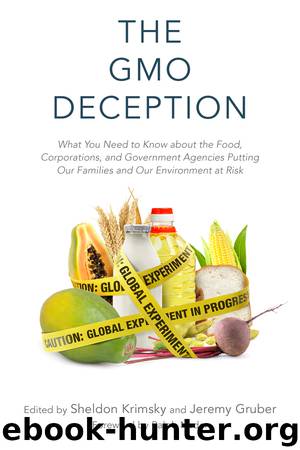The GMO Deception by Sheldon Krimsky

Author:Sheldon Krimsky
Language: eng
Format: epub
Publisher: Skyhorse Publishing
Published: 2014-01-01T05:00:00+00:00
35
The Role of GMOs in Sustainable Agriculture
BY DOUG GURIAN-SHERMAN
Doug Gurian-Sherman, PhD, is a Senior Scientist with the Food and Environment Program at the Union of Concerned Scientists.
Agricultural technologies must improve sustainability by addressing huge challenges to food distribution while reducing environmental harm. Genetic engineering (GE) is most often evaluated based on whether it may cause direct harm through consumption of engineered foods, or direct harm to the environment, such as through killing beneficial organisms. Also important, though less often discussed, is whether it can contribute to reversing the tremendous harm that industrial agriculture is now causing to the environment and public health, and whether the unsustainable use of natural resources, such as fresh water, can be reduced. We need to ask whether GE is addressing, and will address, these challenges. While some of the direct harms from GE remain uncertain, the harms already caused by industrial agriculture that are perpetuated by current genetically modified crops (GMOs), are well documented.
Scientists have recognized that environmental impacts, for which agriculture is a large contributor; including loss of biodiversity, climate change, and nitrogen and phosphorus pollution (major contributors to water pollution such as coastal “dead zones”), are at global tipping points1 And agriculture is also the primary human use of both land and fresh water, at about 70 percent of fresh water withdrawal.
Also important is whether GMOs can contribute, and are needed, to produce enough food sustainably. We produce enough food now. India has the most food insecure people of any country, yet it still exports food. The US has many food insecure citizens, but produces more than enough food. So production is not currently the limiting factor for food security; poverty and disempowerment create the problem. Still, the increasing world population and the increasing demand for animal products, which are an inefficient means of supplying nutrition, and the use of food crops for biofuels, will probably increase demand for food.
It will also be critically important to conserve and rebuild soil fertility, empower women and smallholders, improve infrastructure such as water and food storage and roads, and to increase the resilience of food production to climate change.2
Pesticides have negative impacts on biodiversity, and therefore pesticide use is one measure of the environmental impact of GMOs. Genetic engineering has reduced insecticide use by small amounts, but has greatly increased herbicide use in the US, the largest producer of GE crops.3 Some increases in soil-preserving conservation tillage are attributable to GE crops, but are threatened by herbicide-resistant weeds exacerbated by those crops. And it is clear that conservation tillage can be accomplished economically without GMOs. For example, in the US, most gains in the adoption of conservation tillage occurred prior to the introduction of GMO crops in the US,4 mainly due to changes in farm policy in the 1980s.
Further, resilience to climate change and agricultural pollution has changed little due to the introduction of GMOs, and it has so far not contributed meaningfully to reducing nitrogen pollution. Often overlooked is the fact that GE crops are
Download
This site does not store any files on its server. We only index and link to content provided by other sites. Please contact the content providers to delete copyright contents if any and email us, we'll remove relevant links or contents immediately.
| Anthropology | Archaeology |
| Philosophy | Politics & Government |
| Social Sciences | Sociology |
| Women's Studies |
Cecilia; Or, Memoirs of an Heiress — Volume 1 by Fanny Burney(32434)
Cecilia; Or, Memoirs of an Heiress — Volume 2 by Fanny Burney(31871)
Cecilia; Or, Memoirs of an Heiress — Volume 3 by Fanny Burney(31852)
The Great Music City by Andrea Baker(31348)
We're Going to Need More Wine by Gabrielle Union(18967)
All the Missing Girls by Megan Miranda(15565)
Pimp by Iceberg Slim(14393)
Bombshells: Glamour Girls of a Lifetime by Sullivan Steve(13972)
Talking to Strangers by Malcolm Gladwell(13222)
Norse Mythology by Gaiman Neil(13204)
Fifty Shades Freed by E L James(13157)
For the Love of Europe by Rick Steves(12977)
Mindhunter: Inside the FBI's Elite Serial Crime Unit by John E. Douglas & Mark Olshaker(9200)
Crazy Rich Asians by Kevin Kwan(9167)
The Lost Art of Listening by Michael P. Nichols(7406)
Enlightenment Now: The Case for Reason, Science, Humanism, and Progress by Steven Pinker(7228)
The Four Agreements by Don Miguel Ruiz(6630)
Bad Blood by John Carreyrou(6552)
Weapons of Math Destruction by Cathy O'Neil(6143)
